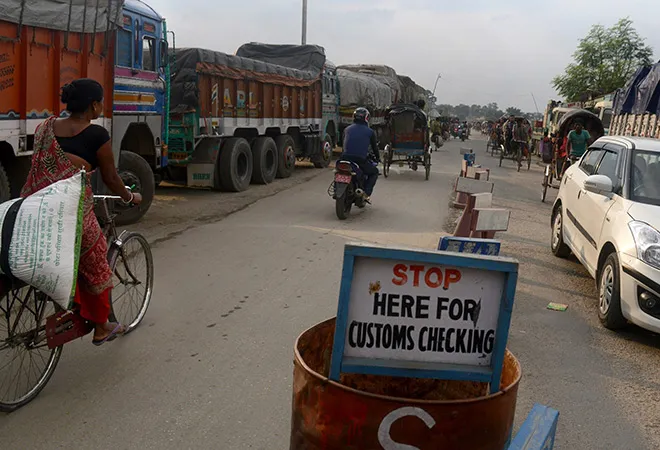
An open border system along the stretch of 1,753 kilometres between Nepal and India is a unique arrangement, which facilitates the unrestricted cross-border movement of people from one country to the other. The citizens of these countries are not required to hold a visa or passport to travel within the two nations. But in the case of China, with whom Nepal also shares an international boundary of 1,400 kilometres, it is mandatory for the citizens of the two countries — except the border inhabitants who are allowed to cross the border without visa and passport for barter trade within 30 kilometres of the border — to carry with them a visa and passport to travel from one country to the other. But after the outbreak of COVID-19, Nepal has closed its international boundaries with both India and China since 24 March.
Despite the open border system between Nepal and India, sometimes it is closed temporarily for a brief period when there are elections on either side of the border, but it soon reopens. However, it is most unusual that the border has been lying closed for over eight months and there is still uncertainty about the prospect of its re-opening. This has caused immense miseries in the lives of hundreds of thousands of people who used to cross the border each day for social, cultural, religious, economic or even political grounds.
Despite the open border system between Nepal and India, sometimes it is closed temporarily for a brief period when there are elections on either side of the border, but it soon reopens.
Both Nepal and India have deployed more security forces in the border regions to avoid cross movement of people to ensure that COVID-19 does not spread from one country to the other. Oftentimes, people are harassed while attempting to cross the border. There have also been cases of killing/injuring of certain persons when they made attempts to cross the border. Despite the restrictions on the movement of people across the border, some still do so through points where the surveillance system is weak. But such cases of cross-movement of people are not very common.
But even amidst a situation where the Nepal-India border is closed, thousands of Nepalese are forced to leave the country to come to India looking for employment. Reports are that a large number of people from the Far Western region of Nepal happened to cross the border through the Trinagar-Gaurifanta and Gaddachawki points in search of jobs in India. These people had earlier returned to Nepal due to growing COVID-19 cases in India and also during the Dashain festival in late October. But since there are no real prospects of employment at home in Nepal, they have no other option but to return to India.
Even amidst a situation where the Nepal-India border is closed, thousands of Nepalese are forced to leave the country to come to India looking for employment.
Estimates are that six to eight million of the people from the hill regions of Nepal are dependent on India for their livelihood. It is difficult for them to survive at home as they don’t have adequate land for cultivation or other alternative means for living. Both the provincial and federal governments in Nepal have made budgetary allocations to create jobs for the Nepalese working abroad, but in practice, nothing tangible has been done in this direction.
Amidst heavy deployment of security forces on both the sides of the Nepal-India border at present, the local inhabitants have been finding it increasingly difficult to cross the border. The situation might worsen if India places laser walls or infrared fencing along the Nepal-India border. Chances of deployment of infrared fencing are high at Sonauli check-post on the Nepal-India border in Uttar Pradesh, which might be extended up to the border region in Uttarakhand.
Locals maintain that unauthorised trade still thrived after the border was closed.
The laser walls are invisible and are monitored through a satellite-based signal command system, which functions even in the dark of night or in low visibility conditions like when there is fog. The blueprint of the infrared fencing and other electronic surveillance gadgets were prepared at the Sashastra Seema Bal (SSB) headquarters in New Delhi. In the past, India installed infrared fencing along the Indo-Pak international border to keep a watch on the movements of terrorists and narcotics.
Reports are that the Nepal government has been incurring huge losses by keeping the Nepal-India border closed. Locals maintain that unauthorised trade still thrived after the border was closed. Earlier, the exports and imports of goods through the official customs points generated huge revenue for the Nepal government. But after closing the border, many items were simply smuggled through unauthorised routes, which has adversely affected the revenue collection at the customs points of the two countries.
Many of the Nepalese traders are nervous as they have been incurring a huge loss.
Significantly, even during the lockdown that was imposed on account of COVID-19, there has not been any problem in transporting essential items between Nepal and India, though the cross-border movement of people was largely affected. But with China, apart from the cross-movement of people, even the trade of goods through land routes was stopped for almost ten months or so. Consequently, nearly 800 containers from China were not allowed to enter Nepal and are still lying on the Chinese side of the Nepal-China border. Many of the Nepalese traders are nervous as they have been incurring a huge loss on this account. Realising the difficulties faced by the Nepalese traders, the Nepal-China Chamber of Commerce has even threatened to launch an agitation if their demand for opening the custom points between the two countries is not addressed.
It seems that there is no real rationale for Nepal to keep the border closed. India, on its part, re-opened its border with Nepal sometime back, though the latter has not yet followed suit. Initially, when the border was closed, the rationale given by the governments of the two countries was to check the transmission of COVID-19 infections. In the meantime, certain quarters in Nepal maintained that the Indian virus was more lethal than even the Italian or Chinese virus and also that coronavirus cases in India were much larger in number as compared to Nepal. But for the last few weeks, the situation has reversed as the daily coronavirus cases have dropped to almost half of its September peak in India; while it is still peaking in Nepal, especially in the Kathmandu Valley and in Pokhara regions. Hence, the sooner the Nepal-India border is opened, the better it is for the interests of the two countries.
The views expressed above belong to the author(s). ORF research and analyses now available on Telegram! Click here to access our curated content — blogs, longforms and interviews.




 PREV
PREV


